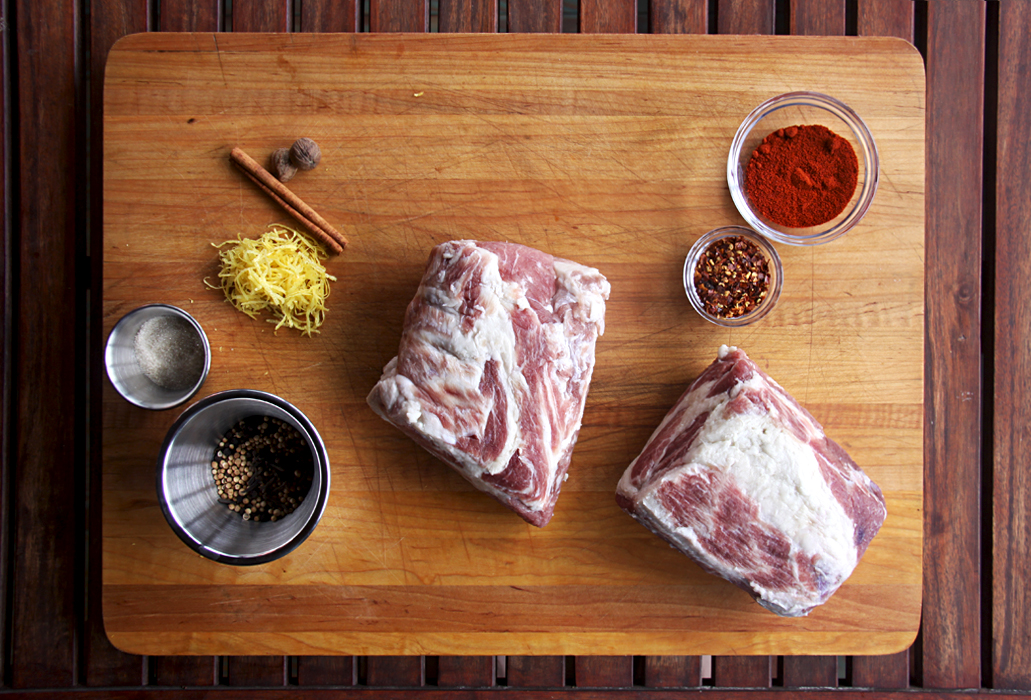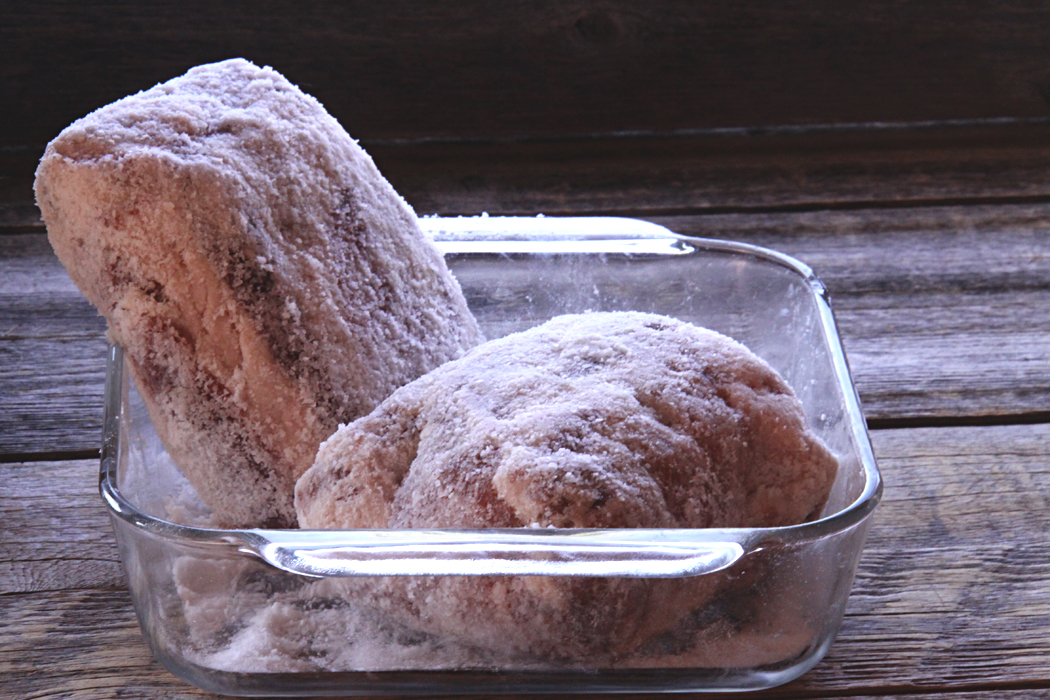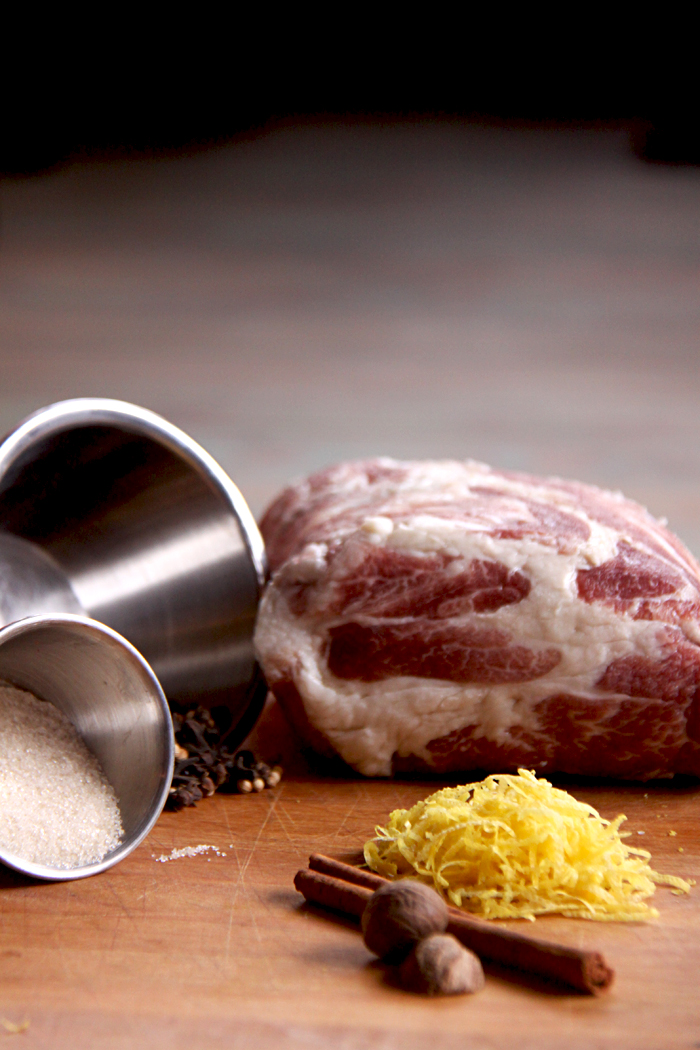CHARCUTEPALOOZA CHALLENGE #11: THE ITALIAN FOR “ARE WE THERE YET?”
 It’s probably inappropriate to describe any feelings toward a pig as a love affair. But it’s true. I have a pig-lover. And my pig-lover’s name is Mangalitsa. I’ve documented my feelings toward the king of swine here. But let me just say again, this is some pig. It’s also my pork of choice for this month’s (second to last) Charcutepalooza project: dry-curing.
It’s probably inappropriate to describe any feelings toward a pig as a love affair. But it’s true. I have a pig-lover. And my pig-lover’s name is Mangalitsa. I’ve documented my feelings toward the king of swine here. But let me just say again, this is some pig. It’s also my pork of choice for this month’s (second to last) Charcutepalooza project: dry-curing.
Dry curing various beasts into tasty bits is a practice that I’ve danced with from time to time over the past few years with varying results. As a general rule, I’ve had a good deal of success curing whole muscles and even lardo. It’s been less so with cured sausages. Since this month’s meat experiment budget went to Mangalitsa, I didn’t’ want to risk getting the chemistry wrong in a sausage and having to throw it all out– a lesson I learned the hard way after an early attempt at a wild boar salami that left me heart broken, wallet broken and feeling like a schnook for wasting the poor critter’s flesh on my own home science experiments. So with all that in mind, I decided to cure coppa (or capicolla, depending on where you’re from), the tasty fatty pig neck that I may actually like better then salami.
The difference for me is a textural thing— coppa, a whole muscle from the neck of the pig, has this great soft chew to it, making it almost like a pork fruit leather. It also carries some nice aged-meat-funk flavors, something that seems to move to the background a little more with some cured sausages. Tasting a really well cured piece of coppa, you can almost taste what the pig ate, who it’s friends were and what it liked to do on it’s Friday nights in the barn. Add the silky, almost pornographic touch of cured Mangalitsa fat and you’re in serious business.
My local Mangalitsa guy wasn’t going to have any pigs till after the new year, so I contacted Heath Putnam Farms and ordered a neck from their distributor in Seattle. Which is sort of the opposite of local if you’re in Texas, but I figure it’s like getting olive oil or wine from Italy. I wanted the best and local had to become a secondary consideration, so my piggy neck came via FedEx. And what a neck it was– a big bastard of a beast with some rib meat still attached and an obscene amount of great looking fat. Just handling the thing made me wish I was the Roman god Swineclese– complete with slave girls fanning me with pork skin and a medium rare chop hanging from my glistening maw, standing atop pig mountain and reigning supreme over all porcine delights. At the very least it made me wish I could reinact something akin to that scene in my backyard without worry that my impressionable young daughter might see Dad doing something that would scar her for life… All I had to do was cure and age it.
I opted to divide the neck into two roughly equal pieces of mini coppa (coppalina?) and cure them with two separate spicings. Dividing the neck also had the advantage of hopefully cutting down my curing and drying times.
Roughly following the recipe from Charcuterie, I rubbed the pieces with a mixture of salt, dextrose and nitrate. I didn’t cut the meat into largish cubes as the recipe indicates. After going to the trouble of procuring the actual cut, I wanted to keep it pure. So I rubbed the two pieces and waited.
A week later I re-rubbed the mini coppa in more cure continued waiting.
ANOTHER week later I washed my fully cured coppa piglets and rubbed them in a spice mixture—one getting the classic paprika and red pepper for a spicy coppa and the other getting a more medieval treatment. I’ve been digging through a translation of Bartolomeo Scappi’s L’Opera (originally published 1570) as well as revisiting Heat and Bill Buford’s descriptions of Dario Cecchini’s meat preparations. At times, both rely heavily on a spicing mixture of sugar, cinnamon, nutmeg, coriander, black pepper, clove and citrus zest. I wanted to try this—I figure if it’s good enough for the pope’s chef and one of the world’s greatest butchers, it’s good enough for my pig. Also, upon close inspection, the spicing blend isn’t that incredibly different than what some modern recipes call for in sweet coppa. Spices applied, I encased and tied the necklets with some 90mm synthetic casing and butcher’s twine, hung them at room temp for a day and then placed them into in my curing fridge at about 65% humidity and 50 degrees.
This is where the painful waiting began. And let me assure you, I’m used to recipes that take some time. A good brew can be 90 days plus in the making and fermenting. But this… this was difficult. Difficult enough to start feeling like the term “slow food movement” was some wize ass joke created solely at my own expense. Maybe it was the quality of pork (and money) hanging spice-cocooned in my tiny wine fridge. Maybe it was the ghost of salumi failures past. Whatever it was, as my coppa was doing mysterious things and slowly, slowly, slowly losing weight, I was seeing my visions of Swineclese become horrible, excruciating tortoise dry-humping a sloth at the zoo slowness.
With each passing day I tinkered with airflow, occasionally weighed the coppas, sprayed them with beneficial mold cultures and just sat there staring at them like a watched pot. At four weeks of drying time and a paltry 10% weight loss I endured the image of my pig-fan waving slave girls becoming one of Steven Wright and Ben Stein doing nude molasses wrestling with some old guy in a walker all in John Wu style slow motion. Yes, it felt that slow.
In the following week I saw the temperatures outside change to fall, my little girl crawl, my birthday come and go, Thanksgiving slip into the rearview, and the deadline for this post come increasingly closer. Yet all I could think of was my trip to the summit of pig mountain feeling more and more far away.
As of the time of this writing, each of my coppas had lost about 150 grams. Well short of the 300ish grams I need for 30% weight loss. My day of ultimate porkery will come, and it will be good. I’m confident of that. I just wish it came on my deadline schedule rather than its own. In the meantime the Swineclese costume will just have to stay in the back of the closet, which is probably best for everybody.







It sounds greek to me. I could hardly follow what you were doing. Hope the end product is worth the wait.
Some of the curing stuff gets a little lingo-y. Basically its a 3 step process: salt curing, seasoning and stuffing, then hanging to dry and… waiting.
I cured pork belly, which I have yet to write about. Where did you get your dextrose and instacure #2? Anywhere in town?
Can’t wait to read it. Did you smoke it or hang dry it pancetta style? I order most of my curing stuff from butcherpacker.com, they’ve got a pretty good selection of stuff and most of the casings you’ll need.
Those look delicious! I did a noix de jambon (Jambon de Camont) and cut it too small so it lost 30% of the weight by the end of cold-smoking. But it tasted good! I then salt cured and hung part of a pork belly. I’m not sure if it’s supposed to lose 30% of its weight, but based on some internet research, I could hang it for months. I think I’ll go for three weeks minimum..
I hope your coppas turn out fine…. If they do, I think I’ll try some too. Capicolla is one of my favorite cured meats.
Thanks Linda, I hope they turn out too. I’ll keep you updated. I’ve never let pancetta go for very long, I always get impatient and eat it.
Hello fellow Texan! Your writing is hilarious (did you really drop a Steven Wright reference?), and I am now inspired to order up some Mangalitsa swine goodness. Keep us posted on the coppas!
Thanks Dan. Revival Market down in Houston sells Mangalitsa down in Houston, it’s like pig gold and costs just about as much but it really is worth it: really, really intense flavor and buttery fat. You guys are out of Dallas, right? Just checked out your salami post– looks delicious, especially with the Peppoli!
the photos look great, jake! is there really a cook book from a pope’s chef from the 16th century?
Yes there is. And if you need a good recipe for lampreys soaked in milk, I’m your man.
Many of my salami aren’t ready yet. I pulled a couple out of the curing facility (wine fridge) and hung them in the kitchen to speed them up a bit, which worked. But I’m guessing your payoff is going to be huge.
Favorite Steven Wright line: “What’s another word for thesaurus?”
They definitely seem to follow their own schedule. This post happened to catch me in the height of impatient bastard mode– a stage I enter during most long term curing and brewing projects that leads to a lot of sampling of very green beer and some obsessive sausage pinching… wait that doesn’t sound right.
I’ll be sure to post on the final results, I’ve already got a laundry list of things I want to do with it. Not least of which is a hot coppa and clam pizza.
Little coppe= coppette
Thanks Scott,
It’s funny, I complained about how slow the process was, but a month-plus later and I’m still waiting to lose the final 100 grams. They smell great though. Can’t wait to cut into one when they’re ready.
I’ve had them take over 5 months. It’s tough.
Just curious, how much does a neck cost?
I got that one from Chefshop in Seattle. It ended up being around $90 with shipping and everything. But it had quite a bit of extra meat on it that turned into a little bit of nice ragu and some pork confit, it had some extra fat that I rendered into lard, plus the two coppa that I made out of it are pretty hefty. It ain’t cheap, but the quality of the pork fat is worth it alone.
ohhhhh… yeeeeah. Necks are steep! I’ll keep buying my cured meats from Olympic Provisions in that case.
Did you get to enjoy good food on your trip to the PNW? Come back and visit again over the summer when it’s REALLY nice here!